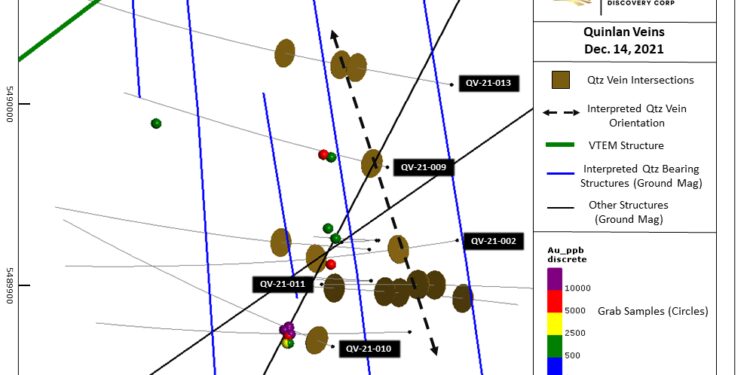Exploits Discovery Corp. (CSE:NFLD) has received early results from its Exploits Subzone drill programme in Newfoundland.
The company received results and completed initial analysis on six of its 13 hole, 2,235m exploration programme at the Quinlan Veins Project so far with one notable intersection of 8.69 g/t Au over 0.45m at 11m downhole in drill hole QV-21-009. Drill Holes QV-21-01, -04,- 05, -06, -07 did not return significant gold assays.
The company plans to release detailed results and analysis on Schooner and Jonathans Pond once a sufficient quantity of assays have been received.
The drill has moved to the Little Joanna Project where drilling is testing an interpreted secondary fault, identified from geophysics by Goldspot Discoveries, this structure is interpreted to be a splay off the Dog Bay Line.
Surface samples collected for Exploits in this area returned grades ranging from up to 194 g/t Au (with visible gold) to trace.
President and CEO Jeff Swinoga, said going forward, the company intends to drill the True Grit-Grub line target, its targets on the Appleton Fault in the Port Albert Peninsula and continue regional exploration to develop additional drill targets next year.
“We are pleased to commence the reporting of our initial assay results for Quinlan and we look forward to updating investors on each of our numerous targets on our large land package around New Found Gold,” Mr Swinoga said.
“Our local team, Goldspot Discoveries and our technical advisory board are fully engaged in the assessment of our data and assay results as they trickle in. As experienced by other exploration companies in the area, it takes time to go from seeing gold in outcrop to defining ‘Discovery grade’ assays in drilling. We look forward to an exciting 2022 as we look to become the next major exploration success in the Exploits Subzone, Central Newfoundland.”
Quinlan Veins Drilling
The Quinlan Veins drilling area is located within the Dog Bay Gold Project at the northern extent of the Exploits Subzone. 2021 drilling was planned to test the down dip and strike extension of multiple 50 to 70 cm wide mineralised outcropping quartz veins that produced high-grade grab samples (up to 61.3 g/t Au).
Drill results indicate that some vein intersections display similar orientations to the interpreted north-to-north northwest trending geophysical lineaments identified from ground magnetic geophysical interpretation.
13 drill holes were completed at the Quinlan Veins totalling 2,235M. All drill holes intersected siliciclastic sand/siltstone and felsic volcanic units with rare occurrences of felsic dykes. Sedimentary units display a general northwest-southeast trending bedding shallowly dipping to the southwest. Quartz veining was sparse with the most significant intersections (10 – 67 cm wide) observed in drill holes QV-21-002, QV-21-009, QV-21-010, QV-21-011, and QV-21-012.
The mineralised quartz vein intersected in QV-21-009 is interpreted to be the down dip extension of the outcropping quartz vein observed to the west of the drill collar. Structural measurements taken from QV-21-002 (assays pending) and QV-21-009 indicate a correlation between moderate to steeply dipping veins intersected in these holes. Quartz vein intersections observed in QV-21-011 (assays pending) and QV-21-013 (assays pending) provide additional evidence for the potential strike extension of the intersected quartz vein.
For further information please visit: https://exploitsdiscovery.com/












